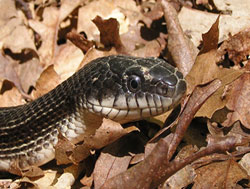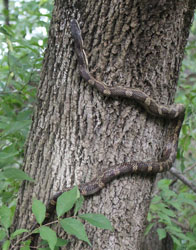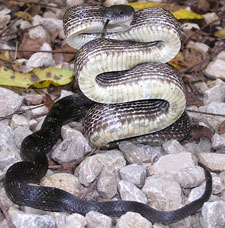Main Content
Article
Gray Ratsnake
(Pantherophis spiloides)

Classification
Non-venomous
Key characteristics
Body mostly black or dark brown, some have a blotched pattern; mouth, chin and throat are white.
Description
The gray ratsnake is a large, thick-bodied snake (42-72 inches) that is square in cross section. Juveniles have a conspicuous color pattern of dark blotches on pale gray and do not resemble the adults.
Adults usually retain some of this darker blotching on a lighter background throughout their lives,but may completely lose the pattern and appear solid black. Some adults will have red or orange pigment show through. The light-colored belly has dark square blotches that resemble a checkered pattern.

Habitat
Gray ratsnakes are typically found in deciduous woodlands, prairies, stream valleys, and on rocky hillsides. They are often found in farm buildings and old foundations.
Diet
Gray ratsnakes are constrictors and primarily eat mice and other rodents, birds and bird eggs.
Habits
Gray ratsnakes are exceptional climbers and often climb trees to bask or search for prey. They are often found in the rafters of barns or other buildings. These snakes may “freeze” when encountered, pulling their body into a series of kinks.
Range
Statewide in Indiana, with the exception of the northwest prairie pocket.
Species similar in appearance
Black kingsnake, prairie kingsnake, western foxsnake, racer
Other info
 Gray ratsnakes are beneficial to humans because they consume a fair amount of rodent pests from fields, barns and gardens. Males take part in “combat dances” in order to establish dominance in competition for mates. If cornered, they will usually coil up and vibrate their tail, and may strike. The vibration of the tail is convincing, leading them to be mistaken for a rattlesnake.
Gray ratsnakes are beneficial to humans because they consume a fair amount of rodent pests from fields, barns and gardens. Males take part in “combat dances” in order to establish dominance in competition for mates. If cornered, they will usually coil up and vibrate their tail, and may strike. The vibration of the tail is convincing, leading them to be mistaken for a rattlesnake.
Also called black ratsnake, black snake, cow snake or chicken snake.
